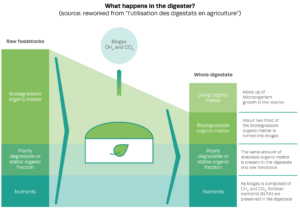EBA: “Exploring digestate’s contribution to healthy soils”

The EBA is launching a comprehensive white paper exploring the potential of digestate in fostering healthy soils and advancing sustainable agricultural practices across Europe. Further work is also carried out via the FER-PLAY project, assessing multiple types of alternative fertilsers.
From reducing reliance on costly synthetic fertilisers to promoting effective soil management and restoration, digestate emerges as a key player in addressing mineral imbalances in soils and facilitating efficient carbon capture.
Moreover, its utilisation aligns with ongoing developments in EU carbon farming policies, positioning it as a cornerstone in Europe’s transition to a greener, more sustainable agricultural sector.
What is digestate?
During the anaerobic digestion process, biogas is produced alongside another valuable stream, called digestate. While a portion of the organics from the raw feedstock is converted to biogas during the process, the mineral fraction remains largely intact in the digestate. This makes it an appealing organic-mineral fertiliser.
Raw feedstocks for anaerobic digestion are largely composed of biodegradable organic matter, poorly degradable or stable organic fraction and nutrients.
First, about two thirds of the biodegradable organic matter is turned into biogas, heavily reducing its share in the digestate.
Second, for the stable organic fraction, the same amount is present in the digestate and raw feedstock. This stable organic fraction is particularly beneficial for soils as it serves as precursor for humus material, thus improving the clay-humus complex of soils.
Thirdly, as biogas is composed of methane and carbon dioxide, fertiliser elements (N,P,K) are preserved in the digestate. Moreover, some of these elements are transformed in the AD reactor to the benefit of plant growth. For example, the organic nitrogen in the substrate is partly mineralised into ammonium, a readily available source of nitrogen for plants.
Regulatory framework
Several legislations regulate the production, application and marketing of digestate in the European Union.
These policies encompass various aspects of digestate management, including its production processes, quality standards, application rates and environmental considerations.
They often depend on the input used in the anaerobic digestion process. Policies governing digestate at EU level include the Waste Framework Directive, the Animal By-Products Regulation, the Fertilisers Regulation, and the Nitrates Directive and the Sewage Sludge Directive.
The framework for digestate at national level is complex and far from being harmonised across Member States.
Individual member states may have their own specific regulations and guidelines pertaining to digestate management to ensure compliance with EU directives and to address local environmental and agricultural needs.
The crucial aspect regarding digestate on a national scale is to have clear legislation providing legal certainty for all types of products and requirements that can be easily operationalised, thus avoiding red-tape.
Additionally, providing an end-of-waste criteria for digestate at national level will have a positive impact on the public perception of digestate. As long as digestate is classified as waste, its value is diminished, hindering its broader acceptance and utilisation.
Regulatory barriers persist, limiting the application of digestate. For example, under the Nitrates directive, digestate from manure can only be applied under 170 kg of nitrogen per hectare per year, whereas synthetic fertilisers can be used above this limit to reach the nitrogen requirement for each specific crop.
The lack of fertiliser or product status for digestate in national law is another major barrier as it leads to a restricted use of digestate or at least a depreciation of its value.
Positive impact on environment, climate, and soil health
Digestate has the potential to drive Europe’s agricultural sector towards regenerative practices and offers an attractive, sustainable alternative to commonly used synthetic fertilisers.
The incorporation of digestate or its derivatives in EU agronomic practices contributes to the achievement of the strategic objectives for resource efficiency, the circular economy and overall environmental stewardship.
Utilising digestate enables a reduction in synthetic fertiliser usage as stipulated by the Farm to Fork strategy, promotes effective soil management and restoration, addresses mineral imbalances and tackles the deficiency of organic matter in soils as outlined by the EU Soil Strategy.
Moreover, it facilitates efficient carbon capture, aligning with ongoing developments in EU carbon farming policies.
This article was written by Lucile Sever, EBA policy officer and Mieke Decorte, EBA technical director


















